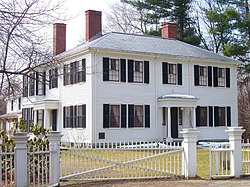Ralph Waldo Emerson House
|
Ralph Waldo Emerson House
|
|
 |
|
| Location | Concord, Massachusetts |
|---|---|
| Coordinates | 42°27′27″N 71°20′39″W / 42.45750°N 71.34417°WCoordinates: 42°27′27″N 71°20′39″W / 42.45750°N 71.34417°W |
| Built | 1828 |
| Part of | Concord Monument Square-Lexington Road Historic District (#66000365) |
| NRHP Reference # | 66000365 |
| Significant dates | |
| Added to NRHP | October 15, 1966 |
| Designated NHL | December 29, 1962 |
| Designated CP | September 13, 1977 |
The Ralph Waldo Emerson House is a house museum located at 18 Cambridge Turnpike, Concord, Massachusetts, and a National Historic Landmark for its associations with American philosopher Ralph Waldo Emerson. He and his family named the home Bush. The museum is open mid-April to mid-October; an admission fee is charged.
The house was built in 1828 by the Coolidge family and named "Coolidge Castle". It was used as a summer house on the village outskirts, beside the Cambridge and Concord Turnpike. It is a four-square, two-story frame building in a house style common to many New England towns.
While Ralph Waldo Emerson was preparing to marry Lydia Jackson (whom he called "Lidian"), he told her he could not live in her home town of Plymouth, Massachusetts. "Plymouth is streets", he wrote to her, "I live in the wide champaign." He had previously lived in Concord at The Old Manse, the Emerson family home, and hoped to return to that town. In July 1835, he wrote in his journal, "I bought my house and two acres six rods of land of John T. Coolidge for 3,500 dollars." He and Jackson married on September 14 and moved into the home the next day, along with his mother.
In a contemporary letter, he writes that he is pleased to avoid the trouble of building, but writes: "It is in a mean place, and cannot be fine until trees and flowers give it a character of its own". To that end, he spent between $400 and $500 for enlargements and finishing. The money came from a settlement with the family of his first wife, Ellen Tucker, who had died young. He wrote that he hoped to "crowd so many books and papers, and, if possible, wise friends into it, that it shall have as much wit as it can carry." It became a central meeting place for philosophers, idealists, and poets.
Emerson remained in the house for the rest of his life. In it he wrote his famous essays "The American Scholar" and "Self Reliance". He also entertained a host of notable neighbors and visitors including Bronson and Louisa May Alcott, Margaret Fuller, and Henry David Thoreau. Beginning in July 1836, the home hosted the meetings of the Transcendental Club, a group which included Orestes Brownson, Theodore Parker, and others.
...
Wikipedia


